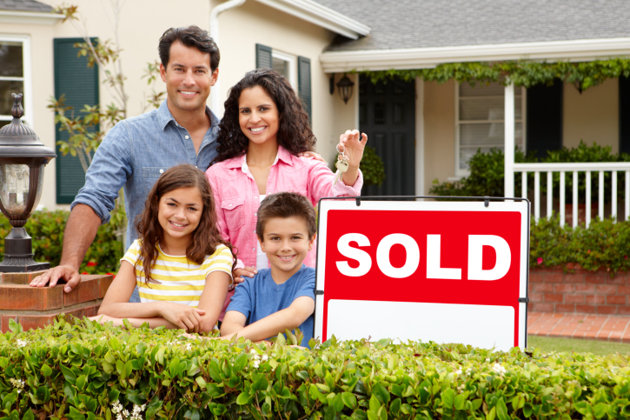The recent rise in mortgage rates has made buying a house a little more expensive: the increase in the 30-year fixed rate over the past month from 3.4% to 3.9% (Freddie Mac) raised the monthly payment on a $200,000 mortgage by $56, or 6%. However, because mortgage rates are still near long-term lows, and because prices fell so much after the housing bubble burst and remain low relative to rents even after recent price increases, buying is still much cheaper than renting. That means that the recent jump in rates doesn’t change the rent-versus-buy math much.
Rates are likely to keep rising, but how far must rates rise before buying a home starts to look expensive relative to renting? To answer this, we updated our Rent vs. Buy analysis with the latest asking prices and rents from March, April, and May 2013. Following our standard approach, we calculated the cost of buying and renting for identical sets of properties, including maintenance, insurance, taxes, closing costs, down payment, sales proceeds, and, of course, the monthly mortgage payment on a 30-year fixed-rate loan with 20% down and monthly rent. We assume people will stay in their homes for 7 years, deduct their mortgage interest and property tax payments at the 25% tax bracket, and get modest home price appreciation (see the detailed methodology and example here). Here’s what we found:
Buying remains cheaper than renting so long as mortgage rates are below 10.5%. At 3.9%, the current 30-year fixed rate according to Freddie Mac, buying is 41% cheaper than renting nationally. With a 5% mortgage rate, buying is still 34% cheaper than renting nationally. Mortgage rates would have to rise a huge amount – to 10.5% – to tip the math in favor of renting, which isn’t impossible. Rates were that high throughout the 1980s, but have been consistently below 10.5% since May 1990.
Each local market, of course, has its own mortgage rate “tipping point” when renting becomes cheaper than buying a home. At 3.9%, buying is cheaper than renting in all of the 100 largest metros, which means the tipping point is above 3.9% everywhere. The tipping point is lowest in San Jose, which would tip in favor of renting if rates reach 5.2%. It’s between 5% and 6% in San Francisco and Honolulu, and between 6% and 7% in New York and Orange County, CA.
| 10 Metros with the Lowest Mortgage-Rate Tipping Point | ||
| # | U.S. Metro | Mortgage rate below which buying is cheaper than renting |
| 1 | San Jose, CA | 5.2% |
| 2 | San Francisco, CA | 5.4% |
| 3 | Honolulu, HI | 5.8% |
| 4 | New York, NY-NJ | 6.8% |
| 5 | Orange County, CA | 6.8% |
| 6 | Los Angeles, CA | 7.5% |
| 7 | San Diego, CA | 7.5% |
| 8 | Ventura County, CA | 8.0% |
| 9 | Sacramento, CA | 8.0% |
| 10 | Oakland, CA | 8.2% |
But for 78 of the 100 largest metros, the tipping point is 10% or higher. In fact the tipping point is above 20% in Cleveland, Memphis, Detroit, and several other metros in the Midwest and South.
| 10 Metros with the Highest Mortgage-Rate Tipping Point | ||
| # | U.S. Metro | Mortgage rate below which buying is cheaper than renting |
| 1 | Detroit, MI | 35.8% |
| 2 | Memphis, TN-MS-AR | 21.0% |
| 3 | Gary, IN | 20.8% |
| 4 | Warren-Troy-Farmington Hills, MI | 20.2% |
| 5 | Toledo, OH | 20.1% |
| 6 | Cleveland, OH | 20.0% |
| 7 | Dayton, OH | 19.2% |
| 8 | Grand Rapids, MI | 18.4% |
| 9 | Akron, OH | 17.4% |
| 10 | Kansas City, MO-KS | 16.9% |
Of course, the tipping point also depends on how long you plan to stay in your next home (we assume 7 years) and whether you itemize your deductions (we assume you do). For instance, if you don’t itemize, or if the mortgage interest and property tax deductions were eliminated entirely, buying would still be 29% cheaper than renting at a mortgage rate of 3.9%, and the tipping point when renting becomes cheaper than buying would be 7.5%.
But just because buying is cheaper than renting, it doesn’t mean you can buy. Lots of people who want to buy don’t have the downpayment or can’t get a mortgage. Even people who can swing it financially might not be able to buy right away, before rates rise further, because they might not find the home they want quickly with inventory still so tight.
So if the recent increase in mortgage rates doesn’t change the rent-versus-buy equation substantially, why does it matter? The main effect is to reduce the demand for refinancing. Unlike homebuying, refinancing is a relatively straightforward financial decision: although refinancing has upfront costs, refinancing doesn’t require finding a home, thinking hard about your lifestyle, or moving. Since rates have been low for so long, many people who were able to refinance, already have. As a result, the demand for refinancing is now dropping.
For people who haven’t yet refinanced – and for people looking to buy – rising rates do make housing more expensive. Rates are now on the rise and are likely to keep rising, thanks to the strengthening economy and the Fed eventually trying less hard to keep rates low. But it will take big rate increases to turn off prospective homebuyers. At today’s prices and rents, rates would have to rise to levels we haven’t seen in 20 years before renting is cheaper than buying a home on average across the country.
The author of this article is: Forbes.com
See the original post at: http://homes.yahoo.com/news/until-mortgage-rates-hit-10-5—buying-will-still-be-cheaper-than-renting-225920815.html
At GayRealEstate.com, we keep you updated with all the gay realtor, lesbian realtor, gay realty, gay real estate and general real estate news affecting the LGBT community coast to coast, and in your neighborhood.
Click here for list of gay realtors, lesbian realtors and gay friendly realtors Nationwide.
If you have a real estate story that you’d like to share with us with the gay and lesbian real estate community, please contact us at: manager@gayrealestate.com



